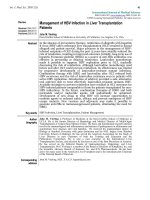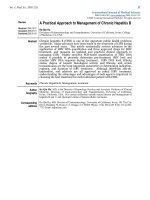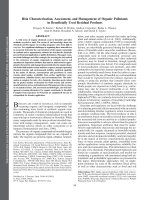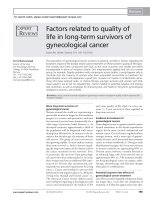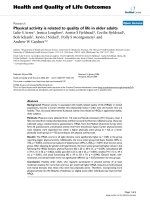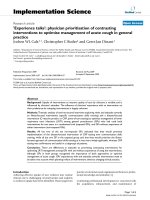Water conflicts related to management of multi-purpose reservoirs in Vu Gia - Thu Bon River Basin
Bạn đang xem bản rút gọn của tài liệu. Xem và tải ngay bản đầy đủ của tài liệu tại đây (1.11 MB, 97 trang )
VIETNAM NATIONAL UNIVERSITY, HANOI
VIETNAM JAPAN UNIVERSITY
NGUYEN THI NHAT ANH
WATER CONFLICTS
RELATED TO MANAGEMENT
OF MULTI-PURPOSE RESERVOIRS
IN VU GIA - THU BON RIVER BASIN
MASTER'S THESIS
Hanoi, June 2019
VIETNAM NATIONAL UNIVERSITY, HANOI
VIETNAM JAPAN UNIVERSITY
NGUYEN THI NHAT ANH
WATER CONFLICTS
RELATED TO MANAGEMENT
OF MULTI-PURPOSE RESERVOIRS
IN VU GIA - THU BON RIVER BASIN
RESEARCH SUPERVISOR:
Prof. SHIGETO NAKA
Assoc. Prof. MASAKAZU FUKUZUMI
Dr. NGUYEN NGOC HUY
Hanoi, June 2019
CONTENTS
Acknowledgments .......................................................................................................... iii
Abstract ...........................................................................................................................iv
List of Abbreviation ......................................................................................................... v
List of Tables...................................................................................................................vi
List of Figures .............................................................................................................. viii
1. Introduction ............................................................................................................... 1
1.1. General topic and research background ............................................................. 1
1.2. Research objectives ............................................................................................ 2
1.3. Research gap and research contribution ............................................................. 3
1.4. Research scope ................................................................................................... 4
1.5. Research methods and framework ...................................................................... 4
2. Conceptual framework and Literature review .......................................................... 6
2.1. Conceptual framework of Water conflict and Reservoir .................................... 6
2.1.1. Water conflict .............................................................................................. 6
2.1.2. Water conflict resolution ............................................................................. 8
2.1.3. Reservoirs .................................................................................................... 9
2.2. Research on Water conflicts ............................................................................. 10
2.2.1. Research on Water conflicts in Vietnamese river basin ............................ 10
2.2.2. Research on water allocation (to find payoff function) ............................. 13
2.3. Research on Vu Gia – Thu Bon River Basin .................................................... 16
2.3.1. Research on VGTB RB related to social or environmental aspects. ......... 16
2.3.2. Research on VGTB RB about main water users in VGTB RB ................. 17
3. Methodology ........................................................................................................... 19
3.1. Theoretical approach ........................................................................................ 19
3.1.1. Game theory ............................................................................................... 19
3.1.2. Game theoretical approach can solve conflict ........................................... 19
3.2. Game theory model .......................................................................................... 21
3.2.1. Game Tree .................................................................................................. 21
3.2.2. Profit functions .......................................................................................... 23
4. Current situation of water conflict .......................................................................... 25
4.1. Context of Vu Gia – Thu Bon River Basin ...................................................... 25
i
4.1.1. Natural conditions ...................................................................................... 25
4.1.2. Social-economic conditions ....................................................................... 26
4.2. Water resources (supply side) .......................................................................... 26
4.3. Water consumption (demand side) ................................................................... 28
4.3.1. Hydropower ............................................................................................... 28
4.3.2. Irrigation .................................................................................................... 30
4.3.3. Urban water supply .................................................................................... 31
4.4. Water balance ................................................................................................... 33
4.5. Water resource management in VGTB RB ...................................................... 35
4.5.1. Water resource management at basin level in Vietnam ............................ 35
4.5.2. Water resource management in VGTB RB ............................................... 36
4.5.3. Management of reservoir system in VGTB RB ........................................ 37
4.5.4. Procedure for operation of inter-reservoir system in VGTB RB............... 38
4.6. Water conflict related to multi-purpose reservoir system ................................ 40
5. Discussion and Policy Recommendation................................................................ 44
5.1. Finding .............................................................................................................. 44
5.1.1. Game theoretical analysis .......................................................................... 44
5.1.2. Analysis of practical model ....................................................................... 50
5.1.3. Analysis of modified model ....................................................................... 62
5.2. Discussion ......................................................................................................... 67
5.3. Policy recommendation .................................................................................... 69
5.4. Limitation and Future research ......................................................................... 70
Conclusion...................................................................................................................... 72
Reference ........................................................................................................................ 73
Appendix A. Data ........................................................................................................... 80
A1. Irrigated water level for paddy ............................................................................ 80
A2. Planted area and yield of paddy........................................................................... 81
A3. Scenarios on sharing water from H (based on Procedure 1537) ......................... 82
Appendix B. Specific examples for Practical model ..................................................... 85
B1. Example 1 ............................................................................................................ 85
B2. Example 2 ............................................................................................................ 86
B3. Example 3 ............................................................................................................ 87
ii
ACKNOWLEDGMENTS
Conducting the research is a journey to discover yourself and to develop critical thinking.
On that journey, supervisors and companions are indispensable.
Firstly, I am particularly grateful for the assistance given by my supervisors for his
valuable and constructive suggestions during the planning and development of this
research work. Assistance provided by Naka Shigeto Sensei, which gave me great
inspiration and led me to the academic world, was greatly appreciated. The knowledge I
learned from Fukuzumi Masakazu Sensei in game theory gave me a great and attractive
economic tool to build my original model. Lastly, with his rich practical experience,
Nguyen Ngoc Huy Sensei helped me understand a great deal more about the reality of
the water sector in Vietnam.
In this journey, I was also fortunate to be instructed by lecturers at Vietnam Japan
University and to be able to discuss with other researchers from VACI 2019. I would
like to offer my special thanks to Mr. Yoshifumi Hino in the MBA program, Mr. Koshi
Yoshida and Mr. Makoto Tamura in the MCCD program helped me gain a lot of
knowledge about water, hydropower and game theory. In addition, I am grateful for the
assistance given by Mr. Dao Trong Tu for helping me to understand the water resource
management. Moreover, I would like to thank the MPP program and VJU for creating
what I think is the most favorable academic environment. Here, I had opportunities to
discuss with my colleagues, who were always willing to listen to even the vaguest ideas
of mine.
Finally, I would like to express my sincere thanks to my lovely family and my
enthusiastic friends, without whose endless motivations and support this work would
have been impossible.
iii
ABSTRACT
Water conflict is becoming an urgent problem over the world because of rapid economic
development leading to the rapid increase of water demand, and global climate change
to the decrease of water availability in season dry. This study is about water conflict
occurring in Vu Gia - Thu Bon river basin among three main water users: hydropower
reservoirs in upstream as well as an irrigation system and urban water supply in
downstream. In order to understand deeply their interactions, this study builds a game
theoretical model to describe the current conflict and their benefits in exploiting water.
From the general model, the practical model is calculated by secondary data and then is
modified with water right weight and average values. The initial results are that although
the profitability for the whole agricultural sector is the largest, the average value is
negligible. In contrast, the profitability of hydropower and water supply companies is
lower but more concentrated. In the perspectives of policymakers, it is essential to
analyse the movement of each player, consider the total payoff values and use control
variables as “refund” and “punishment” to adjust some water user’s behaviors.
iv
LIST OF ABBREVIATION
Abbreviation
Meaning
HPP
Hydropower Plant
WTP
Water Plant
VGTB
Vu Gia – Thu Bon
RB
River basin
RBO
River basin organization
DAWACO
Da Nang Water Supply Company
NE
Nash equilibrium
SPNE
Subgame perfect Nash equilibrium
MONRE
Ministry of Natural Resources and Environment
MARD
Ministry of Agriculture and Rural Development
MOIT
Ministry of Industry and Trade
v
LIST OF TABLES
Table 3.1: Similarities of water conflict and game theory ............................................. 20
Table 4.1: Water flow of dry season and flood season in VGTB RB ............................ 27
Table 4.2: Irrigation system of VGTB RB ..................................................................... 31
Table 4.3: Capacity of main water plants of DAWACO ............................................... 33
Table 4.4: Water supply-demand gap index of VGTB RB ............................................ 34
Table 4.5: Water exploitation index of VGTB RB ........................................................ 34
Table 4.6: River basin organisations in VGTB RB ....................................................... 37
Table 4.7: Main documents for procedure for operation of inter-reservoir system in
VGTB ............................................................................................................................. 39
Table 4.8: Changes in water resources of Vu Gia River ................................................ 43
Table 5.1: Matrix of Sub-game 1 in general model ....................................................... 44
Table 5.2: Matrix of Sub-game 2 in general model ....................................................... 45
Table 5.3: Outcomes of VGTB game’s example model ................................................ 48
Table 5.4: The basis to calculate M-value of H (hydropower plants) ........................... 51
Table 5.5: Profit of hydropower plants in VGTB game’s practical model .................... 51
Table 5.6: The basis to calculate M-value of I (irrigation system) ................................ 53
Table 5.7: Profit of Irrigation in VGTB game’s practical model .................................. 53
Table 5.8: M-value of H, I and C ................................................................................... 54
Table 5.9: Guaranteed value for water demand of downstream .................................... 55
Table 5.10: Total sharing water from three hydropower reservoirs in three scenarios . 56
Table 5.11: Outcomes of VGTB game’s practical model .............................................. 58
Table 5.12: Outcomes of VGTB game’s practical model (example) ............................ 58
vi
Table 5.13: M-value of three players with water right weight (γ) based on average profit
........................................................................................................................................ 62
Table 5.14: Outcomes of VGTB game’s modified model ............................................. 64
Table 5.15: Outcomes of VGTB game’s modified model (example) ............................ 64
Table 5.16: Social payoff in general model, practical model and modified model (𝓥𝑺𝑾)
........................................................................................................................................ 65
vii
LIST OF FIGURES
Figure 1.1: Research framework based on the demand side and supply side .................. 5
Figure 2.1: Four dimensions of resources scarcity .......................................................... 7
Figure 3.1: Game tree with three players ....................................................................... 21
Figure 5.1: Irrigation planning map of Quang Nam province ....................................... 46
Figure 5.2: Game tree with dominant strategies and value of payoffs of general model
........................................................................................................................................ 47
Figure 5.3: Game tree with dominant strategies and value of payoffs of practical model
........................................................................................................................................ 57
Figure 5.4: Payoffs of C - Urban water supply in VGTB game’s practical model........ 59
Figure 5.5: Payoffs of I - Irrigation in VGTB game’s practical model ......................... 60
Figure 5.6: Payoffs of H - Hydropower in VGTB game’s practical model ................... 60
Figure 5.7: Game tree with dominant strategies and value of payoffs of modified model
........................................................................................................................................ 63
Figure 5.8: Total payoffs of three players in VGTB game’s practical model ............... 66
Figure 5.9: Total payoffs of three players in VGTB game’s modified model ............... 66
viii
1. INTRODUCTION
1.1.
General topic and research background
Water resources in Vietnam are relatively abundant with an annual water withdrawal per
capita around 9,560 m3/person, but water resources are unevenly distributed across space
and time. Vietnam has a strong and growing economy - the GDP growth rate in 2018 is
7.08%, which is the country’s highest level of growth since 2008 and a large population
scale with about 97 billion people as of 2019, ranking 14th in the world in terms of
population. As a result, the demand for food, energy, and water has been on the increase.
Moreover, various international reports have stated that Vietnam belongs to a group of
countries most affected by climate change and sea level rise. According to The Global
Climate Risk Index1 for 2016, Vietnam is the 5th most affected country by climate change.
Thus, the water availability is reduced, leading to the situation of exacerbating the foodenergy-water nexus. In this context, water resources are decreased in both quantity and
quality, leading to a wide range of potential problems and becoming the source of water
conflicts.
Vu Gia – Thu Bon River Basin is one of Vietnam's biggest basins, which was not an
exception from this trend of water conflict. Water resources of Vu Gia - Thu Bon River
Basin is quite abundant with the amount of inflow in the dry season reaching 4,280
m3/person/year, ranking 3rd in Vietnam (only lower than the Mekong and Sesan RB).
This basin also has dramatic increases in economic growth and urbanization. Most
noticeably in this area is the coastal plain area of Da Nang City and Hoi An City, which
have high population density and dynamic economic activities. Therefore, water demand
for development purposes is increasing especially rapidly in these downstream areas. It
1
The Global Climate Risk Index (CRI), developed by Germanwatch, analyses the quantifiable impacts of
extreme weather events.
1
should be noted that this river basin also belongs to the Central of Vietnam, one of the
areas in the country that are most vulnerable to impacts of climate change every year.
Therefore, it is understandable when conflict arises here.
In comparison with other basins, VGTB RB has a great potential for hydropower
exploitation, ranking 4th in Vietnam for total capacity can be exploited (2030 Water
Resources Group, 2017). The rapid development of hydropower since the 2000s in the
upstream areas has affected water resources throughout the basin, especially by changing
the natural flow of rivers. Therefore, conflicts over water related to hydropower
reservoirs are noticeable in many basins, including VGTB RB. Currently, VGTB RB has
about 60 hydropower plants in the plan with a total design capacity of 1,502 MW (L. A.
Tuan & Nga, 2016). Most large hydropower plants belong to the cascade hydropower
systems which are constructed on Dak Mi River, Bung River, A Vuong River, Con River,
and Tranh River.
There have been so many studies from the social or environmental perspectives about
the negative impacts of these reservoirs on the VGTB RB. This study aims to achieve a
similar purpose as that of these studies but is based on the economic viewpoint, with a
focus on analysing the link between upstream and downstream’ use of limited water
resources. More particularly, this study aims to examine the strategic interactions among
upstream water users (hydropower) and downstream water users (irrigation and urban
water supply), thereby suggesting policy recommendations.
Therefore, the topic of this study is “Water conflicts related to management of multipurpose reservoirs in Vu Gia - Thu Bon River Basin”.
1.2.
Research objectives
Water conflicts have been occurring on most river basins. However, each region has
been facing and solving the conflict in different ways with typical characteristics.
Therefore, the first goal of this study is to clarify the current situation of water conflicts.
2
After understanding the current state of conflict, based on an analysis of the scenarios,
the next goal of the study is to suggest solutions to solve these water conflicts.
To achieve the above objectives, this research will answer the following research
questions:
✓ Which kind of water conflict is occurring in VGTB RB? Why water
conflicts related to reservoirs are the highlight?
✓ How to solve the negative consequence of these conflicts in the viewpoint
of economics?
1.3.
Research gap and research contribution
• Research gap
Studies on water resources in the VGTB RB are mostly single-disciplinary studies in the
fields of hydropower, irrigation (agriculture) or urban water supply , which means
they do not mention the relationship with other related fields. Studies on reservoirs
often focus on the environmental and social impacts on the surrounding regions, such as
resettlement issues for residents in mountainous areas, or the problems of declining riverbed ecosystems and degradation of the forest environment. Moreover, there is rarely any
research on game theory in Vietnam, except for the Mekong basin. Therefore, there has
been no research related to game theory in VGTB RB.
Therefore, this study uses an interdisciplinary approach (studying the correlation
between three sectors of water use: hydropower, irrigation, urban water supply) from an
economic point of view and using game theory as water conflict resolution.
• Research contribution
First, the study brings a game theory approach to the field of water conflicts in Vietnam
to understand the interactions among water users. Second, this study contributes to
3
resolving the conflicts related to hydropower reservoirs in VGTB RB. Finally, the author
provides practical suggestions for the operation of a river basin organisation.
1.4.
Research scope
The research site is VGTB RB including Quang Nam province and Da Nang City. Water
resource management at river basin can be considered in dimensions of quantity-quality
or dimension of surface – underground water. This research focuses on the quantity of
surface water in VGTB RB with three components:
✓ Water resource: big reservoirs in upstream
✓ Off-stream demand: Water supply for Da Nang City and Irrigation system
in Quang Nam
✓ In-stream demand: Hydropower
1.5.
Research methods and framework
This study uses qualitative methods and secondary data, which includes a variety of
types: reports from international organizations in relevant sectors, legal documents of
the central government of Vietnam as well as local governments in Quang Nam province
and Da Nang City, scholarly articles on game theory and river basin, statistical materials
from GSO, official websites of relevant companies and organization or state authorities...
Legal documents are helpful to contextualize existing policies and understand the price
of electricity, the price of water, the cost of agricultural production as well as standards
related to usages of water. Some online newspapers are used to get an initial observation
of the ongoing conflict. Following, this information is compared with scholarly studies
to understand the current situation in VGTB RB. Data to calculate payoff functions in
game theory model is collected from reports, official websites and statistic organisations.
The research framework shown in Figure 1.1 indicates that analysis of water demand
side (part 4.3) and water supply side (part 4.2) at basin level is useful to understand water
balance (part 4.4) and then water scarcity which leading directly to water conflict (4.6).
4
Figure 1.1: Research framework based on the demand side and supply side
The dissertation is structured in the following chapters:
✓ Part 1 is introduction including research topic and objectives as well as
explain briefly about studied areas and methods used.
✓ Part 2 is the conceptual framework and literature review part.
✓ Part 3 is the methodology part which explains why game theory can be
considered as conflict resolutions.
✓ Part 4 is about the current situation of conflicts happing in VGTB RB.
✓ Last part is a discussion for results of game theory model as well as
recommendation for policymakers.
5
2. CONCEPTUAL FRAMEWORK AND LITERATURE REVIEW
2.1.
Conceptual framework of Water conflict and Reservoir
2.1.1. Water conflict
Report of UNDP in 2008 cited a definition of Netherlands Organisation for Scientific
Research that conflict is “a process that begins when an individual or group perceives
differences and opposition between oneself and another individual or group about
interests and resources, beliefs, values or practices that matter to them”.
This view considered water conflict as social conflict is quite similar to the view
considered water conflict as a disagreement of water users about water quantity at a given
quality with distribution depends on space and time for a particular purpose (Esfahani,
Kerachian, & Mortazavi-Naeini, 2006). The United Nations in the PCCP project (From
Potential Conflict to Cooperation Potential) 2 also identifies that water conflicts arise
from contradicting interests of water consumers with differential purposes, whether
agricultural, industrial or domestic, in both the public and private sectors.
Water conflicts can be considered as one kind of environmental conflicts related to
exploit, use and manage water resources. According to Libiszewski (1992), resources
scarcity has four dimensions as illustrated in Figure 2.1.
Three first dimensions lead to traditional conflicts related to the distribution of natural
resources. The last dimension leads to environmental conflicts due to overuse or
pollution issues. Water is one kind of natural resources, and water scarcity also has four
dimensions, leading to water conflicts from both the distribution side and environment
side.
2
/>
6
Figure 2.1: Four dimensions of resources scarcity
Handbook of GWP & INBO for integrated river basin management published in 2009
indicates that the river basin is a practical hydrological unit for water resource
management. Islam in 2011 also claims that due to water conflicts over different sectors
and various regions, the basin becomes the appropriate unit to solve the challenges of
water resource management.
Water conflicts at a river basin involve so many linkages. Research of Nepal, Flügel, &
Shrestha (2014) considers upstream-downstream linkages as unidirectional externalities
because water use of the downstream mostly depends on the action of actors in upstream.
For instance, if upstream actors change the usage of the land, water availability in
downstream will be impacted directly.
From an economic perspective, Madani (2010) gave a distinctive view of “the conflicts
over water issues” that these conflicts are not only related to cost-benefit analysis, but
they also stem from social and political aspects of water projects such as the issues in
operation and management.
7
To be more detail, in 2000, WCD’s report shows that conflicts over “dams” have
emphasized in the past due to managers ignore the social and environmental impacts of
dams. Another possible reason can be a failure to fulfill commitments of environmental
protection in a report of environmental impact assessment of projects, or failures to obey
the rules of the legal system and internal guidelines. Moreover, past existence and
inequalities have not been resolved, and experience with dispute resolution is still poor
can lead to current conflicts.
In this study water conflicts among users arise from opposition interests in the
context of lack of water and occur in relation to the operation and management of
hydropower reservoirs in upstream.
2.1.2. Water conflict resolution
According to the report of UNDP in 2008, there are some recommendations to solve
water conflicts:
✓ Litigation based on the existing legal system with court participation to
resolve the discord.
✓ Alternative Dispute Resolution (ADR): seek consent of the parties by
means of negotiation, mediation, and arbitration.
✓ Preventing conflict by enticing participation of relevant stakeholders.
The approach of UNDP is in term of management. In addition, there are other approaches
to solving water conflicts. Water engineers consider water conflict due to unfair or
unequal allocation of resources, so they use a hydrological model with simulation tools
to find the most efficient allocation. In another way, economists focus on the rational
water users who pursue individual or collective interests, so they use an economic model
with optimisation functions based on benefits from water exploitation. These approaches
can be combined.
8
In an economic approach, Madani (2010) compares game theoretical methods and
conventional optimization methods in order to solve water conflict. If conventional
approach solves a single-decision-maker problem, game theoretical approach can be
used to solve multi-decision-maker problems. In order to research multi-objective,
optimization will use a function which represents for the whole system or uses weights
with binding conditions. The basic assumption of game theory is that each player is selfinterested, so they have a trend to optimize his own objective. This is opposite to
optimization in which each decision makers can cooperate completely to gain the optimal
benefit for the whole system.
Based on optimisation methods, decision makers (water users) will optimise the benefits
for the whole system despite the possible losses to themselves. Based on game theoretical
methods, players (water users) only pursue self-interest without regarding whether their
decisions will injure other players or the whole system.
2.1.3. Reservoirs
According to Water Words Dictionary or definitions on the website of ICOLD
(International Commission on Large Dams), the dam is built as a barrier to impound or
divert the water flow, and the reservoir is a station to store water, which is created by
building a dam. The dam or reservoir can be used for many purposes such as irrigation,
hydropower, water supply… Debate on hydropower reservoirs is controversy nowadays.
Reservoirs mentioned in this research are hydropower reservoirs. A typical hydropower
plant includes three components: a power plant to produce electricity, a dam to control
the flow of water, and a reservoir to store water. The water behind the dam runs through
an intake and causes a turbine to turn, then an electricity generator will be spun.
According to OECD & IEA (2012), a hydropower plant (HPP) has three types: (1) Runof-river plants generate energy based on natural river flow, depending on the variability
of inflows; (2) Reservoir (or storage) plants store water in a reservoir so it can provide
9
electricity on demand; and (3) Pumped storage plants pump water from a lower reservoir
into an upper reservoir when electricity supply exceeds demand.
Run-of-river plants and reservoir plants can be combined in cascade hydropower systems.
A vast reservoir in the upper position can generally discharge water for several run-ofriver plants in a lower position. And pumped storage plants can utilise the water storage
of reservoir HPPs.
Water resource management has changed from sectoral to integrated management, and
from administrative to hydrological management (means river basin). Reservoirs are an
important part of the river basin. Therefore, management of reservoirs has also shifted
from single-purpose management to multi-purpose management in order to effectively
exploit water resources. According to OECD & IEA (2012), incorporation of multipurpose had been emphasised from the report of WCD (2000). After that, other
organisations also mention this multi-purpose approach for hydropower reservoirs such
as: Electricité de France and World Water Council with the term “Multipurpose Water
Uses of Hydropower Reservoirs” in report of Branche in 2015, ICOLD with the term
“Multipurpose Water Storage Dams” and International Energy Agency with the term
“Hydropower Services” in a report in 2017.
2.2.
Research on Water conflicts
2.2.1. Research on Water conflicts in Vietnamese river basin
• Ba River Basin
The Ba River Basin is one of the largest river systems in Vietnam, located in the Central
Highlands. The Ba River basin has very typical characteristics that are directly related to
the exploitation of water resources by reservoir systems (N. D. Tuan, Dung, & Sy, 2015).
The main features of this system are the combination of reservoirs in main rivers and
tributaries, between hydropower and irrigation, and even water transfer to another basin.
10
In this system, there is An Khe-Ka Nak hydroelectric reservoir, which accumulates water
in upstream of the Ba river for electricity generation, and then releases water to the Con
river, causing the changing of flow scheme in the Ba river.
Research of Tam, Hung, and Le in 2012 has applied the system analysis theory in
combination with the WEAP model to assess the Ba River Basin's water resources
according to 3 scenarios taking into account the operation of the hydropower system: 2
scenarios for period 2000-2010 and 1 scenario for the period 2011-2020. The results
show that the water demand in the later period is so high that the current system cannot
meet. The authors also point out that the procedure for the inter-lake operation is more
efficiency by increasing the amount of water stored in the whole reservoir system.
Regarding Ankhe hydroelectricity, the study confirmed that it is impossible to satisfy
both two purposes that are water demand in downstream and high-power efficiency in
upstream.
Giang and his co-workers3 have published two scientific papers on the impact of the
reservoir system in the Ba River Basin based on the use of 32 hydrological parameters
of the Hydrologic Indicators of Alteration (IHA). The first punishment in 2016 evaluated
this impact on the hydrological regime, results in that this reservoir system plays an
important role in diminishing the maximum flow but has a negative effect in the
hydrological regime in the dry season at Cung Son station. The second pubishment in
2017 focused on the change of sediment regime, results in that reservoirs contribute to
sand mud imbalance leading to consequences such as erosion, river banks in lowland
delta and sedimentation, erosion in the estuary area.
Based on “Research on a scientific foundation to determine the mechanism of sedimentation and landslide as
well as solutions to stabilise the estuaries of Da Dien and Da Nong in Phu Yen province for sustainable
development in infrastructure and socio-economy" (Code DTDL.CN.15/15).
3
11
Nga (2017) used the hydrological-economic model to provide optimal water allocation
in the Ba river basin. This model examines the water balance according to the
hydrological point of view and the effect of water use from an economic point of view
with an optimal approach. The initial conclusions of this study relate to hydropower,
irrigation and urban water supply such as: (1) Total net profit from water users has a
nonlinear relationship with the total volume of runoff in the basin; (2) The increase in
the price of agricultural products or the cost of producing electricity only has an effect
on the total net profit of each sector, without affecting the allocation of water; (3)
Irrigation efficiency has a significant effect on the optimal irrigated area for each crop
and does not significantly affect power production in power factories; and (4) Even in
the case of high urbanization with the rapidly increasing demand for living and industry,
water demand for hydropower and agriculture is not affected.
• Srepok river basin
The Srepok river basin is located in the west of the Truong Son mountain range, in the
Central Highlands, and is one of the basins with the largest hydroelectric potential in
Vietnam. The whole Srepok basin has cascade hydropower systems up to 10 ladders.
Only 20% of the flood season's water must be spilled is not used for electricity generation.
Research of Duong (2015) has systematized a series of environmental conflicts in the
exploitation of surface water resources in the Srepok river basin, many of which are
related to hydropower. The author states that hydropower is the most predominant sector,
creating both positive and negative impacts on the basin; and the environmental conflict
between hydropower and other stakeholders is the most complex. The author also
pointed out that the procedure of operating the reservoir approved by the state agencies
on electricity but the inter-reservoir operation procedure at the basin level approved by
Ministry of Natural Resources and Environment (MONRE) results in the certain
conflicts during the operation of these reservoirs.
12
Khoi (2013) used the hydrological model and climate change scenario to determine the
change of flow in the Srepok river basin. The results prove that under the influence of
climate change scenarios, the flow in this basin will decrease sharply during the dry
season, leading to the concerns about water scarcity.
Le in 2017 has applied MIKE BASIN model to calculate water balance for Srepok's 10
sub-basins. Although the Srepok river basin is not a lack of water basin, 8/10 sub-basins
lack water with an increasing risk of drought. The reasons are that the deep
differentiation between the wet and dry seasons; the increasing demand for irrigation
water (mainly for coffee and rice) more in the dry season; and the inefficient and
insufficient irrigation systems. Although the activities of reservoirs for both irrigation
and hydropower are mentioned, the study shows the positive impact of large hydropower
reservoirs to regulate the flow during both flood and dry seasons without considering the
negative externalities.
In summary, the Ba river basin and Srepok river basin in the Central Highlands have
many similarities in geography and natural conditions with VGTB RB. Thu Bon River's
upstream branch also originates from this area. Moreover, water conflicts arising in these
three basins are strongly related to hydropower reservoirs and inter-reservoir operation
procedures. In particular, the case of diversion of Ankhe hydropower in Ba River Basin
is similar to Dak Mi 4 hydropower in VGTB RB.
2.2.2. Research on water allocation (to find payoff function)
There are many causes of conflict over water in which water allocation is unfair and
effective. To solve the water allocation problem, the researchers often use hydrological
models or hydrological-economic models.
Hydrological models often consider water demand as a determined value. Water
engineers will rely on the results of these models to provide technical suggestions. In the
13
hydrological-economic model, water is comprehended as a commodity and has an
economic value which changes according to space, time and purpose.
The hydrological model provides a static allocation scheme while water allocation
according to the hydrological-economic model is dynamic. The studies using
hydrological-economic models all use the objective function of economic profits
obtained from the exploitation of water for different purposes.
In Vietnam, there are some studies on water allocation using hydrological and economic
models to solve the optimal water allocation problem such as: study of Ringler & Nguyen
Vu (2004) research the optimal water balance of the Dong Nai river system, taking into
account the regulation of reservoirs and study off Nga (2017) researches on water
allocation for sectors to support the management of Ba river basin.
These studies use the general objective function:
𝑀𝑎𝑥𝑓 (𝑥) = (∑ 𝑉𝐴𝑛𝑛 + ∑ 𝑉𝑃𝑡𝑑 + ∑ 𝑉𝑀𝑠ℎ + ∑ 𝑉𝐼𝑐𝑛 )
𝑛𝑛
𝑡𝑑
𝑠ℎ
(2.1)
𝑐𝑛
VA: water value for agriculture
VM: water value for domestic demand
VI: water value for industrial demand
VP: water value for hydropower
𝑉𝐴𝑛𝑛 = 𝑉𝐴𝑡𝑡 + 𝑉𝐴𝑐𝑛
(2.2)
14
𝑛𝑛𝑛 𝑐𝑟𝑜𝑝
(2.3)
𝑉𝐴𝑡𝑡 = ∑ ∑ [(𝑝𝑟 × 𝑦𝑚) − 𝑐𝑜𝑠𝑡 ] × 𝐴𝑖,𝑗
𝑖=1 𝑗=1
𝑛𝑛𝑛 𝑐𝑟𝑜𝑝 12
− 𝑝𝑟𝑤 × ∑ ∑ ∑ 𝑞𝑡𝑢𝑜𝑖𝑡 × 𝐴𝑖,𝑗 × ∆𝑡
𝑖=1 𝑗=1 𝑡=1
𝑛𝑐ℎ𝑛 12
(2.4)
𝑉𝐴𝑐𝑛 = ∑ ∑ 𝑄𝑐ℎ𝑛𝑖,𝑡 × 𝑛𝑢𝑚𝑖 × ∆𝑡 × (𝑝𝑐ℎ𝑛 − 𝑐𝑐ℎ𝑛)
𝑖=1 𝑡=1
𝑛𝑠ℎ
𝑉𝑀𝑠ℎ = ∑
12
∑
𝑖=1
𝑒
𝑡=1
𝛼⁄
𝜀
𝛽
× 𝐼 ⁄𝜀
1
1
× {(𝑄𝑠ℎ𝑖,𝑡 × ∆𝑡)1− ⁄𝜀 − 𝑄𝑠ℎ∗(1− ⁄𝜀) }
1 − 1⁄𝜀
(2.5)
− (𝑄𝑠ℎ𝑖,𝑡 × ∆𝑡) × 𝑝𝑠ℎ
𝑛𝑐𝑛 12
𝑉𝐼𝑐𝑛 = ∑ ∑
𝑒
𝛾
⁄𝜃
1 − 1⁄𝜃
𝑖=1 𝑡=1
1−1⁄𝜃
× {(𝑄𝑐𝑛𝑖,𝑡 × ∆𝑡)
∗
− (𝑄𝑐𝑛 × ∆𝑡)
(1−1⁄𝜃 )
(2.6)
}
− (𝑄𝑐𝑛𝑖,𝑡 × ∆𝑡) × 𝑝𝑐𝑛
𝑛𝑟𝑝 12
(2.7)
𝑉𝑃𝑡𝑑 = ∑ ∑ ℎ𝑒𝑠𝑜 × 𝑄𝑡𝑑𝑖,𝑡 × ∆𝐻𝑖,𝑡 × ∆𝑡 × (𝑝𝑝 − 𝑐𝑝)
𝑖=1 𝑡=1
This objective function shows benefits from water extraction for different water users.
In these studies, the main water users are agricultural (cultivation, livestock),
hydropower, household, and industry. For each water user, there is an equation to
calculate the benefit in term of the economics of water extraction. Hence, these benefit
functions can be applied in other models such as game theory to indicate payoff functions.
15
